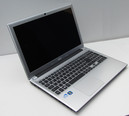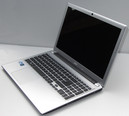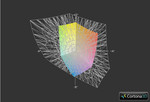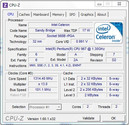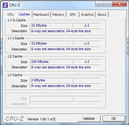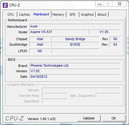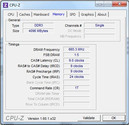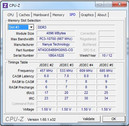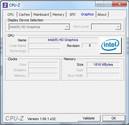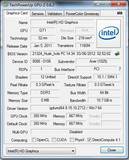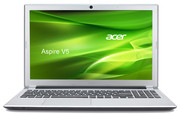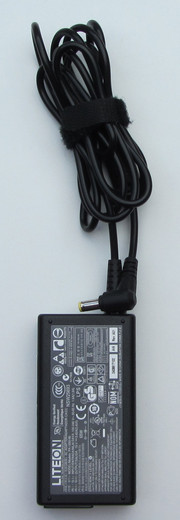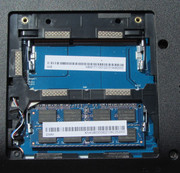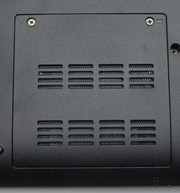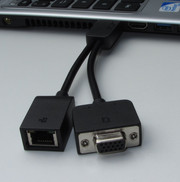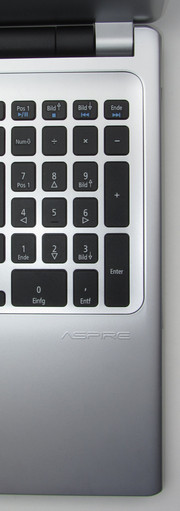Review Acer Aspire V5-531 Notebook

Acer markets its Aspire V5 notebook series as “ultra-slim notebooks”. The idea behind the entire series is to provide consumers with a line of low-priced ultrabook-style notebooks without needing to meet the actual ultrabook specification. The Aspire V5 series notebooks come with screen sizes of 14, 15.6, and 17.3 inches.
In this article, we review the Acer Aspire V5-531 that comes with the equipment one might expect from a 15.6-inch notebook costing 399 Euro ($485 USD) – a 1.3 GHz dual-core Intel Pentium 967, onboard Intel HD Graphics, 4 GB RAM, and a 320 GB Seagate Momentus Thin hard disk.
As only Acer currently offers notebooks in this price range, the primary competition is the superiorly equipped Acer Aspire V5-571G from the same series featuring a Core i5-3317U CPU and discrete GeForce GT 620M. Competitors surpassing the 400 Euro ($485 USD) threshold include the HP 630-LH384EA, HP 635-LH416EA, Acer TravelMate 5744Z-P624G50Mikk, and Lenovo B570-M58G4GE.
Case
The Acer Aspire V5-531 is available in Matte Black, Airy Blue, and Misty Silver. Our test sample uses the silver color scheme and has a very low 23-millimeter (0.9-inch) build height. We found the notebook comfortable to carry around and noted that the device is a bit wider and longer than other 15.6 inch notebooks.
It goes without saying that a sub-400 Euro ($485 USD) notebook will not feature an aluminum case. The Aspire V5-531 is made completely of plastic. While lacking frills and ornaments, the case surface is nonetheless smooth. The Aspire V5-531 clearly shows design elements that resemble those of Apple and might appeal to Apple customers, particularly due to the silver color. However, the imitation falls short and the plastic used for the case looks very cheap. Nonetheless, the case quality and impression are acceptable considering the 400 Euro ($485 USD) retail price. We presume the black model makes a slightly better impression in terms of quality and appearance.
The case makes a fairly rigid impression and does not flex or bend significantly under pressure. The area above the optical drive tended to yield a bit more during our testing, a common weakness in notebooks. While the gaps are not always even, the workmanship is reasonable for the price.
The ultra-slim design results in a display lid that appears very thin, but this thinness comes at the cost of stability. The display lid teeters easily and the entire lid dents inward slightly when applying pressure to the display’s back. By comparison, the similar Aspire V5-571G appears to have a more solid lid as these problems did not occur during our testing of that model.
When the display lid is opened beyond 90 degrees, the weight distribution changes and the base unit no longer rests stably as the front left rubber foot hovers about one centimeter above the work surface. A small cover on the underside allows access to the system’s memory modules but maintenance on the notebook is otherwise impossible without significant disassembly.
Connectivity
The slim design of the Aspire V5-531 takes its toll on connectivity but Acer nonetheless managed to include most of the important interfaces. The front of the notebook houses a memory card reader that supports SD and MMC cards. The other interfaces – one HDMI port, one USB 3.0 port, two USB 2.0 ports, and one headphone jack – are all located on the notebook’s left side. Beside these, there is a socket on the notebook’s front edge that allows the connection of a dongle which adds connectors for Gigabit Ethernet and VGA output.
Communication
For the Aspire V5-531, Acer includes all typical communications options. The Atheros Wi-Fi module supports the typical IEEE 802.11b/g/n. The notebook also includes a Bluetooth 4.0 module. Wired network connectivity is supported by the Realtek Gigabit Ethernet module via the included dongle connector. Skype users will likely appreciate the 1.3-megapixel webcam integrated in the display frame.
Accessories
The notebook comes with a 65 Watt power supply that is approximately the size of a box of 24 crayons and has dimensions 9.3 x 4.9 x 2.6 cm (3.7 x 1.9 x 1.0 in). The included 4-cell lithium ion battery has a rated capacity of 2500 mAh. As well, the aforementioned Ethernet/VGA dongle is included as well.
The notebook does not include a Windows 7 DVD for reinstallation, nor does it include a recovery partition for system restoration. Instead, Acer includes a pre-installed security tool that enables the creation of a Windows 7 installation image which should allow for system recovery. For owners of the Acer V5-531, we would like to point out that we will have an upcoming news article on how to obtain a full version DVD of Windows 7.
When it comes to software, Acer provides more than one might expect from such a budget notebook. For example, McAfee Internet Security Suite is pre-installed to protect the notebook. Cyberlink MediaEspresso is also installed to serve as a video, picture, and music converter, allowing media to be used on smartphones, tablets, and game consoles. As well, Microsoft Office 2010 Starter Edition is included. A 30-day trial version of NTI Media Maker 9 is also pre-installed for writing CDs and DVDs. Beyond these, Acer includes a few of its small applications and tools.
Maintenance
Due to the Aspire V5-531’s slim build, maintenance and upgrading of the notebook is virtually impossible. The singular exception is the small cover on the unit’s underside which allows the owner to access the memory banks. Only one of the two banks is occupied, and thus it is easy to upgrade the notebook’s memory pool.
However, access to the other components is highly restricted. It is possible to access the Wi-Fi module by removing the keyboard but doing so only allows the user to check the antenna cables as the module itself can only be removed through further disassembly. The hard disk cannot be accessed at all without removing the entire upper shell of the base unit.
Warranty
The Aspire V5-531 includes a 24-month carry-in warranty. In the event of a defect, the owner is required to send or deliver the notebook to Acer’s service center. The warranty can be upgraded to 3 years for a premium of 60 Euro ($75 USD) and must be purchased and activated within the first 365 days after purchase.
Input Devices
Keyboard
The keyboard in the Aspire V5-531 occupies the device’s entire width and uses a full-sized chiclet layout including a number pad. The keyboard uses 15 x 15 mm (0.59 x 0.59 in) keys with 4 mm (0.16 in) gaps and yields slightly under pressure. The black plastic used for these keys does not convey a quality impression even though the workmanship and fit are flawless. We found the key drop to be very short and the stroke just sufficient. Typing on the keyboard is easily manageable but could also be considerably crisper. As a result, this author would prefer not to use the keyboard for typing longer texts.
Touchpad
The Aspire V5-531 uses a 10.5 x 7.8 cm (0.41 x 0.31 in) Synaptics ClickPad. The ClickPad resembles a traditional touchpad but lacks independent mouse buttons. The entire ClickPad is clickable and when the lower part of the pad is clicked, it results in either a left or right mouse click depending on where the finger is positioned.
We found that the ClickPad’s fit is not perfect. As well, when pressing on the pad in the lower area, it tended to clatter. On the other hand, we found that gliding over the pad was easy despite its slightly roughened texture. We also found that the pad was not hypersensitive and unintentional clicks did not register during our testing. The entire pad supports multi-touch gestures and functions such as two-finger zoom. Drag and drop worked perfectly.
Display
For the Aspire V5-531, Acer chose the glossy LED-backlit 15.6-inch 1366x768 AU Optronics display which is also used in the more expensive Acer Aspire V5-571G. No other screen options are available. This screen delivers exactly what one might expect from a notebook with a price under 400 Euro ($485 USD), but it should be noted that considerably more expensive 15.6-inch notebooks often also use similar screens.
| |||||||||||||||||||||||||
Brightness Distribution: 85 %
Center on Battery: 184 cd/m²
Contrast: 196:1 (Black: 0.94 cd/m²)
39.81% AdobeRGB 1998 (Argyll 3D)
56.3% sRGB (Argyll 3D)
38.25% Display P3 (Argyll 3D)
In our testing, we found the contrast and black value acceptable for the price but the overall display lacked brilliance. However, sometimes even much more expensive notebooks such as the Asus K55VM-SX064V do worse.
We observed a very limited color space. The screen was unable to reproduce the sRGB spectrum and did not even come close to covering the AdobeRGB color spectrum. While this is not important for normal users, this is an important aspect for professional graphics designers and image editors. Neither the V5-531 nor the V5-571G were built for these image-intensive fields and clearly cannot satisfy their needs.
Performance
The Acer Aspire V5-531 features equipment suitable for common applications such as Web surfing, emailing, online chatting, watching DVDs, and word processing. Complex computer games remain beyond the notebook’s capabilities and image processing and video editing are equally out of reach.
Those seeking a more powerful notebook might wish to take a look at the Acer Aspire V5-571G. Otherwise identical to our V5-531 test sample, the Aspire V5-571G adds the power of an Intel Core i5-3317U processor, a dedicated Nvidia GeForce GT 620 graphics card, and a larger hard drive. For those seeking a smaller package but retaining the hardware of the Aspire V5-531, the 14-inch Aspire V5-431 might be an interesting option.
Processor
The Acer Aspire V5-531 is driven by the Sandy Bridge Intel Pentium 967 dual-core ULV (ultra-low-voltage) processor. The processor’s especially low operational voltage results in lower power consumption and serves as a small highlight as ULV processors are typically found in considerably more expensive notebooks.
With a 1.3 GHz processor clock, the Pentium 967 does not support Intel’s Turbo Boost technology which would otherwise allow the processor to dynamically overclock its cores. As a result, the 1.3 GHz base clock is the limit for this processor. Fortunately, the processor’s full performance is available on battery power.
In our testing, we found the Cinebench results meet expectation. The Pentium 967 processor is considerably weaker than the Intel Core i5-3317U processor found in the Acer Aspire V5-571G. The Core i5 processor delivers a Cinebench performance that is two to four times better.
System Performance
In both PCMark 7 and PCMark Vantage, our Acer V5-531 delivered results within the expected range. While the weak configuration was clearly noticeable in the scores, the results are nonetheless on par with similar devices such as the HP Probook 4535s-A1F21EA, HP Probook 4535s-LG855EA, and Lenovo G550.
From a subjective user standpoint, the notebook’s weak equipment is also apparent. In our tests, applications were sluggish to open and Windows 7 itself demonstrated a slow, longer startup. While we criticized the Aspire V5-571G for its hard disk bottleneck, its scores in the PCMark tests were far better than those of the Aspire V5-531.
| PCMark Vantage Result | 2997 points | |
| PCMark 7 Score | 1362 points | |
Help | ||
Storage Devices
The Acer Aspire V5-531 uses a 5400 RPM Seagate Momentus Thin hard drive. The 2.5-inch hard disk is true to its thin branding and has a slim build height of only 7 millimeters (0.28 inch). We measured an average data transfer rate of 74.1 MB/s which is typical for a drive of this class. However, the 22.2 second access time is unusually high. This was clearly noticeable in the form of slight delays when opening programs.
Graphics Card
The Acer Aspire V5-531 uses the Intel HD Graphics integrated graphics chip built into the Pentium 967 processor. While Intel does not provide a more detailed description, we have determined that this graphics solution is based on the Intel HD Graphics 2000 chip and is thus the weakest performing graphics option currently available from Intel. As a result, it lacks certain key features such as Intel QuickSync for HD video playback.
Nonetheless, the system is capable of rendering HD video using software rendering whereby the processor does the work. We tested this by rendering a Full HD 1920x1080 video encoded using H.264. The processor was capable of rendering the video at 75 percent load, and a similar result was found when playing back YouTube videos at a Full HD resolution.
As an older graphics chip, the HD Graphics 2000 is only capable of supporting up to DirectX 10.1, making the 3DMark 11 benchmark impossible to run. We also encountered problems in 3DMark Vantage where the benchmark always aborted just before completion, displaying an error message indicating missing DirectX functions. As a result, we are unable to provide benchmark results for this graphics chip.
This simply highlights the weakness of the Aspire V5-531’s graphics solution, especially when compared with the Nvidia GeForce GT 620M and Intel HD Graphics 4000 graphics cards in the Aspire V5-571G. These allow the V5-571G to play a few current games even at high quality settings. Realistically, however, gaming notebooks should use at least an Nvidia GeForce GT 650M GPU.
| 3DMark 03 Standard | 5965 points | |
| 3DMark 05 Standard | 4540 points | |
| 3DMark 06 Standard Score | 1054 points | |
Help | ||
Gaming Performance
As previously mentioned, the Acer Aspire V5-531 is not a notebook designed for playing computer games. For that, one should turn to the similarly equipped yet more powerful Acer Aspire V5-571G. The Aspire V5-531 did not achieve sufficient frame rates in any of our tested games, even in the lowest possible settings. As well, the games’ load times were not very awe-inspiring either.
| low | med. | high | ultra | |
|---|---|---|---|---|
| StarCraft 2 (2010) | 26.98 | 3.68 | ||
| Deus Ex Human Revolution (2011) | 7.21 |
Emissions
System Noise
The Acer Aspire V5-531 hardly generated any noise in our experience. The fan did not operate continuously and even when running, it was almost inaudible. The only time the notebook yielded a clearly audible noise level was during load. The hard disk was also almost inaudible and, while accessing data, remained quieter than the fan even when operating at the lowest fan speed.
Noise level
| Idle |
| 31.9 / 34 / 34 dB(A) |
| HDD |
| 31.9 dB(A) |
| DVD |
| 35.3 / dB(A) |
| Load |
| 36.4 / 40.1 dB(A) |
 | ||
30 dB silent 40 dB(A) audible 50 dB(A) loud |
||
min: | ||
Temperature
The use of a ULV processor in the Acer Aspire V5-531 is beneficial in terms of the notebook’s temperature. The idle temperature was typically below 30 degrees Celsius (86 degrees Fahrenheit) in most places. The only place that surpassed this temperature was the wrist rest which was still pleasant to the touch.
During full load in our stress test, the temperature surpassed 30 degrees Celsius (86 degrees Fahrenheit) at most of our measurement points and two places exceeded 40 degrees Celsius (104 degrees Fahrenheit). Nonetheless, the temperatures remained within an acceptable range even in this scenario and allowed for a pleasant working environment even though this represents an extreme case and should not be expected during normal use. Lap-top use is definitely possible during routine office work.
(±) The maximum temperature on the upper side is 40.2 °C / 104 F, compared to the average of 34.3 °C / 94 F, ranging from 21.2 to 62.5 °C for the class Office.
(-) The bottom heats up to a maximum of 49.4 °C / 121 F, compared to the average of 36.8 °C / 98 F
(+) In idle usage, the average temperature for the upper side is 28.7 °C / 84 F, compared to the device average of 29.5 °C / 85 F.
(-) The palmrests and touchpad can get very hot to the touch with a maximum of 40.2 °C / 104.4 F.
(-) The average temperature of the palmrest area of similar devices was 27.6 °C / 81.7 F (-12.6 °C / -22.7 F).
Speakers
The Aspire V5-531 has stickers labeled “Dolby Advanced Audio” and “Virtual Surround Sound” to suggest high-end audio equipment. However, the notebook’s low price tag clearly suggests that this is unlikely to be the case. Surprisingly, we found the audio experience to be reasonable. Speech was clear but tended to have a slightly tinny sound. This was not disturbing and there are definitely worse notebook speakers. Both speakers are located on the notebook’s bottom edge and a jack for external speakers is available.
Battery Life
Power Consumption
For our sample Aspire V5-531, we measured a maximum power consumption of 33.9 Watts during full load, a moderate consumption level of 20 to 30 Watts during medium load, and a minimum power consumption of 8 to 10.5 Watts while idle. As a result, the included 65 Watt power supply could almost be called oversized as the V5-531 is quite energy-efficient.
By comparison, the Aspire V5-571G can only achieve the V5-531’s low power consumption while idle. Otherwise the V5-571G’s power consumption is approximately 10 to 20 Watts higher due to the dedicated Nvidia GeForce GT 620M GPU and demonstrated a maximum 49.5 Watt consumption.
| Off / Standby | |
| Idle | |
| Load |
|
Key:
min: | |
Battery Runtime
We used the Battery Eater Reader’s Test to determine a maximum battery life. To simulate idle operation, we set the screen to its minimum brightness, enabled the energy-saving profile, and disabled all wireless modules. In this scenario, the Aspire V5-531 lasted for 5 hours 9 minutes. To measure a load scenario, we used the Battery Eater Classic Test with maximum screen brightness, the high-performance profile, and all wireless modules enabled. The Aspire V5-531 managed a runtime of 1 hour 36 minutes in this test.
We then tested the Aspire V5-531 using our own practical Wi-Fi test where websites were automatically visited every 40 seconds with the energy-saving profile enabled and the screen brightness set to approximately 150 cd/m2. We measured a runtime of 3 hours 24 minutes in this test.
While watching a DVD, the notebook managed a significantly shorter runtime of 2 hours 39 minutes. This is long enough for a single long movie or two rather short ones. In this scenario, Wi-Fi and Bluetooth were disabled, the brightness was set to maximum, and we used the energy-saving or a higher profile in the case of unsmooth DVD playback.
Although very energy-efficient, the Aspire V5-531’s battery runtime is only average when compared with other 15.6-inch notebooks. This is due to the included battery’s fairly low capacity of 37 Wh. The typical batteries of 15.6-inch notebooks have capacities of 50 to 60 Wh. Unfortunately, the ultra-slim design and targeted price prevent the inclusion of a larger battery. A higher battery capacity could have turned this notebook into a true endurance machine.
As an interesting comparison, the Aspire V5-531’s runtime is virtually matched by the Aspire V5-571G. This is surprising because the V5-571G has considerably more powerful equipment. It should be noted that the V5-571G uses a modern ULV processor, the Ivy Bridge Intel Core i5-3317U which is considerably ahead of the Pentium 967 in terms of performance. As well, the Nvidia GeForce GT 620M is automatically disabled by Nvidia Optimus which allows the notebook to save a lot of energy.
Verdict
The Acer Aspire V5-531 is an attractive offer. At a sub-400 Euro ($485 USD) price, the customer gets a weak, quiet, low consumption notebook which can handle routine applications despite its weaker equipment. Moreover, the device almost has an air of elegance due to its thin case. This impression is somewhat downgraded by the plastic case’s cheap impression.
For those seeking a basic notebook for Web browsing, online chatting and Skype, and watching DVDs without spending a lot, the Aspire V5-531 is a good choice. Users who might want to play an occasional game or watch longer videos might want to choose the considerably more powerful Aspire V5-571G. This alternative has virtually the same battery runtime but costs about 200 Euro ($250 USD) more.
We would also like to point out the 24-month warranty that is rarely found among devices of this price range.






